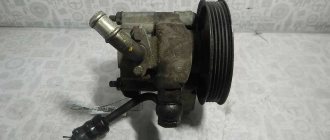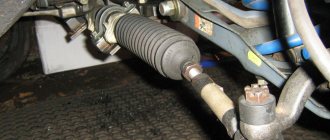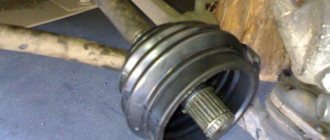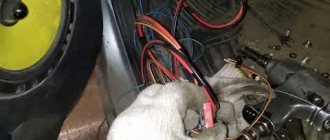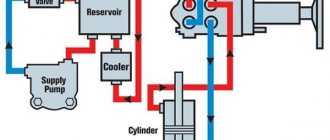Depending on the year of manufacture, the “ten” can be equipped with a hydraulic booster (power steering) or an electric booster (electric power steering). Of course, the second option is preferable, since it makes driving the car easier and more comfortable. If your power steering is worn out or you just want to replace it, then it is recommended to choose the power steering for the VAZ 2110 as an alternative.
This material contains two instructions:
- Installation of power steering.
- Installation of an electric power steering VAZ 2110 instead of a standard power steering.
Before installation, you need to understand the structure of these units, and also find out how they differ from each other.
Analysis of the steering rack of a VAZ 2110 car.
Differences between EUR and power steering
These are completely different units. To understand the main differences, it is enough to study the hydraulic booster. Its main component is a pump driven by the crankshaft, it is integrated with other parts. The operating principle of the hydraulic booster is based on hydraulics.
As for the electric power steering, it is driven by an electric motor. Its design also includes an electronic control unit, a steering shaft with a torsion element and sensors. The EUR works according to a different scheme:
- When the steering wheel rotates, the torsion shaft twists;
- Special sensors record changes in the position of the shaft and send data to the electronic control unit;
- After analyzing the information, the unit sends commands to the electric motor;
- As a result, the unit creates the necessary force or facilitates turning the steering wheel.
Car enthusiasts often argue which option is preferable for the “ten”. In fact, power steering is an obsolete unit that is being actively removed from modern passenger cars. The electric booster works even when the engine is turned off and weighs less than the power steering. The main advantage over “hydraulics” is reliability - the electric unit requires virtually no maintenance. There is less load on the engine, and as a result, less fuel is also needed. The EUR is also good for our conditions because it functions well at low temperatures.
But the electric booster also has its drawbacks. Its design is more complex than that of “hydraulics”, hence the high price. Sometimes the electronic control unit sends incorrect commands, this was especially felt by the owners of the first generation Kalina. If you drive for a long time on a poor-quality road surface (or lack thereof), the EUR may turn off for several minutes due to overheating.
Replacing hoses and oil
Power steering hoses are an important part of it. Therefore, they need an eye and an eye. But what if they still need to be replaced? Should you take your car to a service station? Of course, there is no need, because you can do all this yourself. Usually, hoses are replaced simultaneously with the power steering oil change. And it would be opportune to present joint instructions.
- First you need to lift both front wheels of the car (they should be in the air);
- We find the power steering reservoir from which the oil should be pumped out;
- Pump out the oil;
- Turn the steering wheel all the way in any direction (after this oil will appear in the tank again, which needs to be pumped out again);
- Now turn the steering wheel in the other direction and pump out the oil again;
- We remove the hose, which is the oil conductor (through it, the oil comes from the passenger compartment and enters the tank);
- Turn the steering wheel from side to side (oil should come out again);
Replacing power steering oil
- We take new power steering oil (usually about 800 ml);
- Fill it into the tank to the maximum level;
- Again, turn the steering wheel from side to side (all the way);
- We start the engine for a few seconds, turn it off;
- We turn the steering wheel again;
- Add oil;
- We pump and remove air from the system by turning the steering wheel with the car turned off ten times in each direction (we do the same number of times with the engine running).
When changing the oil, be sure to look at all hoses and pipes. If oil is leaking, this is a sign of a torn or faulty hose that will need to be replaced. Hoses are replaced only after the oil has been completely pumped out. You will need to unscrew the clamps and remove the hoses from the pump. As for installation, new hoses and pipes should be tightened with clamps and not overdo it (hoses easily burst, if anything happens).
Installation of EUR
Required Tools
Let's say you purchased an EUR kit - it could be from a VAZ 2110 or from another model, for example, from a Priora. Prepare the following tools:
- Drill together with a metal drill.
- Set of screwdrivers, grinder.
- Long ruler.
All is ready? Let's move on to installation.
Step-by-step instruction
- You need to remove the standard terminal from the block and place it in the block on the harness. We find the standard drive, which is attached to the block. A free terminal must be installed in its place. Now the wire can be placed between the fasteners.
Adjustment
After assembly, you will need to straighten the steering wheel if it is installed crooked. Separately install the sensor that came with the EUR. If the column casing is cracked, it is better to immediately replace it with a good one. There may be gaps between the front panel and the casing - they must be removed.
Characteristic
At the moment, almost all budget cars are equipped with such an amplifier. However, owners of old cars have a desire to retrofit their car with power steering. This is a very useful option. Even with a large diameter steering wheel, the effort required to control the car will be several times less. This is especially noticeable when parking in densely populated cities. The power steering itself is part of the car's steering system and runs on hydraulic fluid pumped by a pump. This also includes the steering column. The usual factory one does not fit here. There are many advantages of this system.
The first is the comfort of control, because you no longer need to turn the steering wheel as much as before. The second is reliability. The hydraulic booster practically does not fail. The third advantage is ease of maintenance. You will not have any difficulties when operating such a car. Even if the amplifier breaks, you can fix it with your own hands. Moreover, it is quite possible to get to the garage with such a breakdown. The only thing that will happen is that the ease of control will deteriorate. The steering wheel will become “heavy”. By the way, for the first time such an amplifier was installed on Gorky’s “Chaika”. GAZ-13 was the first car with power steering.
( 2 ratings, average 4.5 out of 5 )
Installing power steering - step by step instructions
This instruction is intended for VAZ 2110 cars, which do not have power steering at all. Such models were produced a long time ago, but they can still be found on the road today. In this case, the car can be upgraded with your own hands.
You can install the power steering yourself; for this you will need a power steering kit - today it can be purchased for about 20 thousand. From the tools, prepare a set of keys and screwdrivers; you should also take care of the amplifier fluid in advance.
Is repair possible?
The VAZ 2110 steering rack with power steering is a fairly reliable unit, but even it can fail if the car is used incorrectly.
Repairing the steering mechanism may involve the following steps:
- Repair of power steering rack. In this case, the repair procedure consists of replacing parts from the repair kit. This kit includes sealing elements for the piston and shaft, oil seals, bushings, as well as inserts for pressing the shaft. During this task, the surface of the shaft may be machined.
- Switchgear repair. This procedure involves replacing the upper and inner oil seals, sealing elements and grinding the shaft. If the distributor shows signs of ring wear, the housing will also need to be lined.
- Repair of the rack with restoration of the shaft. In this case, all the steps described above are performed, but in addition to this, you will also need to restore the shaft by building up the babbitt. You will also need to coat it with chrome and grind it.
- If we are talking about a major overhaul, then you will need to perform all the steps described above, as well as completely replace the transverse shaft, its (side) clamp, along with the nuts and distributor. In addition, it may be necessary to replace the high-pressure lines along with the steering rods.
Price issue
The cost of a new EUR today is about 13-18 thousand rubles. On the secondary market you can buy a set for 2-6 thousand. The price for a complete set of power steering is on average about 20 thousand rubles.
Loading …
Differences between EUR and power steering
These are completely different units. To understand the main differences, it’s enough to study the hydraulic booster. Its main component is a pump driven by the crankshaft, it is integrated into parts. The mechanism of operation of the hydraulic booster is based on hydraulics.
Read
As for the electric power steering, it is driven by an electric motor. It also includes an electrical control unit
, control shaft with torsion element and sensors. The EUR works according to a different scheme:
- When the steering wheel rotates, the torsion shaft twists;
- Special sensors record changes in the position of the shaft and send data to the electrical control unit;
- After analyzing the information, the unit sends commands to the electric motor;
- Ultimately, the unit makes the necessary force or simplifies the rotation of the control wheel.
Car owners often argue which option is better for the “ten”. In fact, power steering is an obsolete unit that is being intensively removed from modern passenger cars. The electric booster works even when the engine is turned off and weighs less than the power steering. The main advantage over “hydraulics” is reliability - the electronic unit practically does not require maintenance. The engine is subject to the least load, therefore, less fuel is also needed. The EUR is not bad according to our criteria, in addition to the fact that it works perfectly at subzero temperatures.
Lada 2111 › Logbook › Power steering for 2110 8 cells. Part 1
The topic is old and hackneyed, but I still want to share my experience.
I would like to immediately answer frequently asked questions: Why power steering? After all, the EUR is better/simpler/more reliable/doesn’t take power away from the engine
1. Because the power steering rack has 2.7 turns from lock to lock, and all other 2110/Priora/Kalina racks have 4.2 turns. The only exception is the viburnum sprat rack with 3.1 2. I like it when the steering becomes stronger at speed 3. IMHO the hydraulic rack dampens impacts on the wheels better and allows you not to feel a slip during acceleration. Again, these are just my feelings 4. In principle, I like the idea of a hydraulic booster better. This can be considered religious beliefs
How expensive?
Within 10-12 sput
How difficult and how long does it take to install?
1 full day, nothing complicated, a minimum set of tools required
Components
This is what the most complete set of power steering looks like:
If you remove the set of priors with your own hands, then you will not have any problems, you will be able to get everything and see how it stands, but if you assemble it in parts... Particularly difficult to find is the boot installed in the engine shield, at the entry point of the steering slats in the interior:
Installing power steering - step by step instructions
This instruction is intended for VAZ 2110 cars, which do not have power steering at all. Such models were produced a long time ago, but they can still be found on the road today. In this case, the car can be upgraded with your own hands.
Installation of power steering can be done by yourself
, for this you will need a power steering kit - today it can be purchased for about 20 thousand. From the tools, prepare a set of keys and screwdrivers; you should also take care of the amplifier fluid in advance.
- We dismantle the timing case and install the bracket on three bolts. There are already holes in the interior, so there is no need to drill new ones. Now we install the pin on which the roller will later be installed. There are no holes for it, so we make new ones. Let's put on a video.
Here you can see the fasteners that need to be removed. The photo below shows in detail what needs to be sawed off. After this, securely fix the pump on the bracket and cover it with a pillow. The assembled unit should be placed
on the engine, or rather, in the place where the generator was mounted.
You should undertake such work only if you already have experience in servicing the electrical and power plant of the VAZ 2110. Power steering is directly related to safety, so if you lack experience, it is better to turn to the experts.
Bleeding the brakes of a VAZ 2112. How to do it correctly
In the list of diagnostic measures, bleeding the brakes of the VAZ 2112 is one of the first places. It’s good when car enthusiasts understand this and take it quite seriously. It’s not for nothing that they say: “Why do you need a gas pedal if the brakes don’t work?” Bleeding the VAZ 2112 brakes is primarily necessary to remove air layers from the communications and equipment of the brake system, which lead to malfunctions of the entire well-functioning automotive mechanism. The most critical consequence of the presence of air in the system is its complete failure, when when you press the brake pedal, it falls to the floor without effort and remains in that position. Why and when is bleeding performed? The process, which drivers call “bleeding,” is based on the purpose of removing from the cylinder and underwater hoses of the braking system the layers of air that have penetrated into it. One can object by pointing out that the system is hermetically sealed and only thanks to this technological feature it functions. However, under the influence of constant mechanical loads, as well as material fatigue, the tightness may be broken. Carrying out a daily visual inspection of the car before driving on the road in rare cases may reveal signs of hidden depressurization, which is a consequence of:
- Loose fluid supply hoses;
- Microcracks in tubes, fittings or in the cylinder.
Bleeding must be carried out as one of the stages of work when replacing any equipment included in the functionality of the system. With rare exceptions, when the pads are replaced, however, even such a simple process can also be completed by preventative blowing of the hoses. Stages of work To carry out this type of restoration work, a set of the following tools, materials and auxiliary equipment is required:
- Capacity, preferably a clean bottle of at least 1.5 liters;
- Rubber tube from a medical IV or from a blood transfusion set;
- Clean rags;
- Wrench for 8 and 10, open-end or “bleeder”, which has a special slot;
- Steel brush for cleaning metal surfaces;
- A can of WD-40 to remove traces of dirt and rust;
- New fluid for the system.
Also, to carry out the work conveniently and quickly, you need an assistant who will bleed the brake pedal from the passenger compartment - from this manipulation the whole procedure got its name. At the first stage, air is removed from the discharge cylinder. To do this, the pedal builds up pressure and, alternately unscrewing the fittings on the cylinder, air bubbles are released from them. Prefaces these manipulations by adding fluid to the tank to the maximum possible level. Only after this do they begin to work with the wheel fittings. Bleeding the wheels on VAZ cars is carried out in the following sequence:
- Rear right;
- Front left;
- Rear left;
- Front right;
- *The sequence of processing wheels on VAZ models is determined by their distance from the cylinder, and therefore by the length of the connecting hoses.
However, in the case of the VAZ 2112, this is not critical, since on this model the system is multi-circuit and the sequential wheels do not matter in this matter. The procedure is similar to that done with the central cylinder, only there is only one fitting on the wheel. Even if no repair work has been carried out on the system, the VAZ 2112 brakes should be bled either once every 3 years, or every 4,000-5,000 thousand kilometers. Bleeding is required if the liquid becomes dark, which indicates a loss of its performance characteristics. AutoFlit.ru
- Why do you need an absorber for a VAZ 2114?
- What is the VAZ 2110 gravity valve for?
- Why do you need an adsorber for VAZ 2112?
- VAZ 2110 starter repair kit
- VAZ 2114 how to find out the color of a car by VIN code
- RDT VAZ 2114 signs of malfunction
- VAZ 2110 signs of malfunction
- DMRV VAZ 2114 signs of malfunction
- Dpkv vaz 2114 signs of malfunction
- Signs of a malfunction of the DPD on a VAZ 2112
- VAZ 2114 signs of injector malfunction
Component Benefits
The electric steering wheel has a number of advantages, which led to the fact that it is installed not only on the VAZ 2110, but also on other models of this plant. In addition to technical characteristics, it has other equally important indicators:
- Simplicity of installation work when installing the unit;
- The unit consumes a relatively small amount of electricity;
- The unit does not affect the environmental performance of the car;
- Possible installation of the unit on other VAZ models;
- Parametric indicators, that is, an effective reduction in torque according to an increase in vehicle speed;
- During operation, no additional care or use of various special materials is required;
- At low temperatures, this option for strengthening the steering wheel performs better.
The only drawback of this device is the fact that it works a little weaker than the same hydraulic booster.
New electric power steering VAZ 2110 with components
But in the case of domestic roads, this gain is quite enough to feel comfortable behind the wheel.
A little history
Only 12 years later, in 2002, domestic engineers from Novosibirsk University began developing a Russian electric amplifier. After the completion of the project, the unit was refined and tested for several years at the AvtoVAZ plant.
New device
The engineers' task was to create a worthy analogue to foreign amplifiers, to provide the unit with the necessary advantages, durability and reliability. At the same time, unlike imported analogues, our electric amplifiers were much cheaper.
Today, these devices are produced by the Berdsk Electromechanical Plant, located in Russia and a subsidiary of AvtoVAZ.
Main advantages of the first ES
The electric amplifier would not be so in demand and popular without the obvious advantages that it brought along with its appearance. The strengths of this steering system include:
- The unit operates even when the power unit is turned off;
- The unit allows partial fuel savings, which has a positive effect on fuel consumption;
- Handling is improved in all components;
- Reliability of maneuvers at the highest level;
- Excellent safety record with regular use.
What to do if the steering rack of a VAZ 2110 hits hard
If the steering rack on your VAZ 2110 car hits hard, then the problem lies in severe wear of the tips. I do not recommend performing this repair yourself, as this requires special tools and certain skills. Wheel alignment - no problem, there are already instructions on our website.
When the knocking sound of the steering rack comes from the side of the connection with the steering rod, this defect can be eliminated in a garage.
Procedure:
- Remove the rubber corrugated boot and remove the grease.
- We replace the bushing if it is damaged.
- We clean the spring from various dirt, this can be done with “solarium” or a special one. liquid.
- Install a new rubber boot.
- Then we tighten the bolt that regulates the movement of the sleeve.
Principle of operation
The work of EMURU, that is, the electromechanical power steering, is aimed at reducing the driver’s control efforts. The device is also designed to actively return the steered wheels and steering wheel to their original position after a maneuver. Fewer turns of the steering wheel will return the wheels to their original position.
Thanks to the device, the car returns to straight-line motion faster, which ensures driving safety.
The unit itself is a modular design that is built into the steering column.
The module consists of two main components:
- The power unit is a synchronous electric device;
- Control type controller.
The installation of an electric booster is especially important if the owner of a VAZ 2110 installs wider tires on large-diameter wheels compared to standard factory ones. Such a problem as an “unruly” steering wheel is eliminated in the case of electric power assistance; the steering wheel obeys the driver even with a light touch.
General diagram of electric power steering
If previously the driver had to constantly hold the steering wheel with both hands and put a lot of effort into turning it, now everything can be done with one finger.
Thanks to these indicators, the VAZ 2110 is considered one of the safest cars on domestic roads.
One of the main components of the brake system is the caliper. Details of self-repair of this part are outlined here: https://vazweb.ru/desyatka/tormoza/support.html



